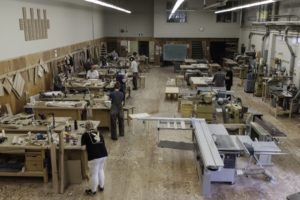The students in Camosun’s Fine Furniture class of 2022 are hosting Chairs, Chairs, Chairs until Sunday, July 10. Not only does this exhibit—being held at Cedar Hill Recreation Centre—have as its title a hilarious play on the name of Mötley Crüe’s 1987 album Girls, Girls, Girls, but it also showcases the students’ many different takes on chairs.
Program head and instructor—and Fine Furniture alumna—Sandra Carr says that doing chairs for the capstone project is a tradition of the program.
“I have students who come in, and in week one of the 10-month program, they’re like, ‘I’m going to make this chair.’ So, I think there’d be a bit of backlash if I changed it. And chairs in furniture making are iconic, and chairs are very personal in the way we interact with them. They’re unlike any piece of furniture where they’re meant to fit the human body. They’re intimate.”

Fine Furniture student Eldie Forget has used the capstone project to design a comfortable and multipurpose meditation stool. Their chair’s design was inspired by their own need for a new meditation stool, as well as the need of others.
“I’ve created a few meditation schools,” says Forget, “and I’ve done these 10-day silent mediations for many years, and we sit down for many hours in a day, and I’ve always switched between sitting cross-legged and kneeling… It just always felt like I had a big pile of cushions or meditation stools that weren’t very comfortable. The stool kind of came from a need for a piece of seating that could do it all.”
Like previous years, the chairs are made of reclaimed, donated Garry oak and arbutus wood. These types of woods are preferred because of Garry oak’s ability to steam bend—a technique showcased in this year’s exhibition—and the arbutus’ natural beauty.
“They’re two of my favourite local woods to work in,” says Carr. “The Garry oak, specifically, is very well suited to doing steam bending, a wood-bending technique that you basically heat up the wood in a steam box and bend it… A couple chairs of this year’s exhibit are using Garry oak specifically to do that technique with them. So, the design kind of centres around using that technique. And the arbutus is beautiful.”
The wood was donated by the Vancouver Island Woodworkers Guild after being approved to be cut down for safety reasons or to make way for new developments. This donated wood creates a valuable tie to the community, says Carr, and an opportunity to promote the local organization.
“The best thing about these two woods is they come from the Woodworkers Guild,” says Carr. “And there’s something really special about using material that’s come from the place we live and work in. So, there’s that tie to that land and a positive tie-in that we’re not cutting down the trees for the material. Instead, the trees have come down for whatever reason. It could be a windfall or, sometimes, development.”
Overall, Carr hopes her students leave the program with a basic woodworking knowledge and an understanding of what comes next. She hopes her instruction and support give them the confidence to take that next step and thrive in their future careers.
“I’d hope they leave with a basic knowledge of woodworking, an understanding of what they need to learn next… A direction, perhaps, of what it is they want to do next,” says Carr. “An exposure and awareness of what the different opportunities are. And I think a sense of personal accomplishment would be a big one, as well.”
